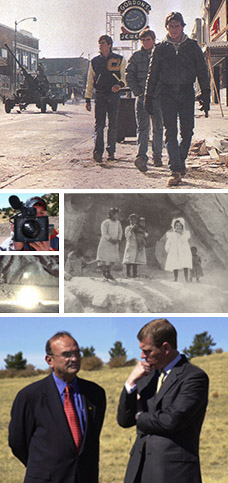
temperature and wind conditions in the lower atmosphere up to altitudes of 4 to 5
km.
Reusable Blast Test Fi
xture
The Reusa
ble Blast Test Fix
ture, co-sponsored by the F
ederal Aviation
Administration (
FAA), is a full-sc ![]()
Technical Operations Level
- ale model of the cargo section of a wide-
- body, commercial passenger aircraft with significant internal structures (floors, frames, and luggage racks). Shock Tube Large diameter shock tube testing provides a source th
- Provides the knowledge and skill for developing policies, procedures, training and operational capabilities to deter, prevent, interdict, respond to, and mitigate the effects of a suicide bombing
- at that can produce blast pressures and durations that are of interest to the safety and security communities. Sled Track Experiments The Sled Track Test Facility uses a 300 meter (1000-foot) long monorail system to conduct dynamic testing of warheads, penetrators, and shape c
- harges. Research Programs EMRTC is a research division of New Mexico Tech and maintains many res
earch programs
- with other university departments. EMRTC also participates in research with several U.S. National Laboratories. Ballistics Testing All gun ranges have orthogonal flash X-ray capability for muzzle X-ray diagnostics. I
- nstrumentation includes a digitized weather monitoring system, Doppler radar, AVL ballistic computer systems, pressure-time transducers, sky screens, acc
- elerometers, strain gauges, thermocouples, and pressure guages. Photographic equipment includes high-speed cameras (10,000 f/s), image motion compensation (IMC) photography (high-speed 16 mm and 35 mm form
- ats), and full-range video capability. The ranges are computer-equipped for data co
- mpilation/correlation. Four fixed temperature conditioning units are available for conditioning cartridges from -46 degrees centigrade to +63 degrees centigrade
- . One of EMRTC's significant strengths is existing inventory of gun systems and its ability to modify these systems to meet experimental ballistic require
- ments. Various standard US Army and US Navy gun systems from a 5.56 NATO to an 8 inch howitzer are located on site. EMRTChas also designed and modified a large range of gun systems that are used to fire specialized and
- Information Collection and Management, Indications, and Warningsprototype projectiles and fragments at more than 2 km/s (6,500 f/s). Gun Ranges 3000 meter Gun Range 1200 meter Gun Range 1000 meter Gun Range Full-Scale Curtain Wall Reaction Structure The Full-Scale Curtain Wall Reaction
- Vulnerability Assessments Structure is located at EMRTC's High Performance Magazine (HPM) test site. The HPM is the largest test site at EMRTC and has the capability of testing up to 20,000 lbs (9,09
- 0 kg) of TNT at standoff distances of up to 500 feet (152 m) fro presents information, techniques, and practical examples of physical, procedural, staffing and operational countermeasures that can be implemented.
- m the reactio provides information on the importance of conducting a risk analysis based on asset, threat, and vulnerability assessments to assist in comparing and selecting effective countermeasures.
- n structure. The reaction structure is capable of accepting curtain walls up to 42 feet wide and 45 feet tall (depending on clearing requirements). There are
floors in the str
ucture (ground, 1st, 2nd, and roof). The ground level, 1st and 2nd floors are fully enclosed on the backside of the structure to preve
- nt wrap-around pressure fro
- Package Bomb and Suicide Belt with Shrapnel Lab
- m entering the t
- est space. Each floor slab has interior dimen
sions of 42 feet wide by 12 feet deep. The reaction structure was designed to withstand approximately 20 psi and 400 psi-ms with no more than 1/2 inch deflections in the upper-most portions of the shear/clearing walls. Structural elements can be adjusted to accommodate any mounting requirements. EMRTC has the capability to fully instrument the reaction structure with an assortment of gauges including, but not limited to, pr
Course Application 
sducers; accele
rometers; linear
displacement (yo-yo), laser displacement, and strain gauges; as well as real-time and digital high-speed video. EMRTC also has the capability of recording up to 100 channels
- @ 1 mega sample per second for eac
- Improvised explosive devices (IEDs)
- h test. Depa
- rtment of Transportation (DOT)/United Nations (UN) Testing and Classificatio
n EMRTC, as an approved Department of Transportation Examining Agency,

